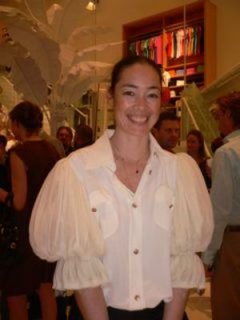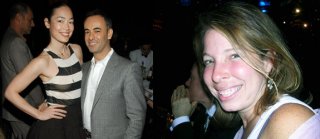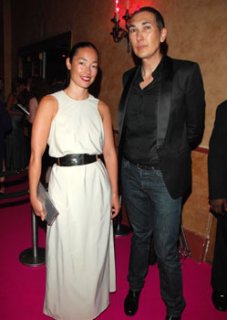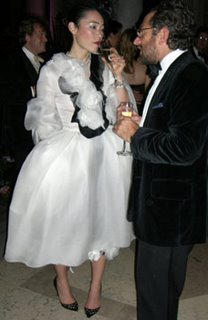wow. i love her. i can't believe she's not more popular on this forum. an-oldish article i came across on nymag.com
The Vision Thing
This month marks the twenty-fifth issue of "Visionaire" -- the homespun, high-concept, $150-a-copy 'zine that's the fashion world's latest must-have accessory.
Add a Comment
1 Comment | Add Yours
00 Comments | Add Yours
A cook clambers into Stephen Gan's bedroom, balancing a platter of turkey burgers fresh from the hibachi in one hand as she negotiates a precarious iron ladder. A handful of Gan's colleagues -- editors, production staff, interns -- drift in to survey a summery buffet: Tomatoes, green salad, iced tea, fresh bread. Just a routine lunch hour in the SoHo offices of
Visionaire magazine.
Visionaire -- in case you don't own one of the 3,300 copies of the last issue -- is the hippest fashion magazine in America, a quirky quarterly that occasionally shows clothes and looks nothing at all like a magazine. "We prefer
publication," says James Kaliardos, one of Gan's two co-editors. "We use
portfolio or
album more than
magazine," adds Gan. "We started it as this
thing somewhere between an art book and a fashion magazine." This month, the thing is celebrating a self-styled anniversary -- its twenty-fifth issue.
Packaged lavishly but with a homespun charm,
Visionaire has more in common with old-fashioned vanity projects like Fleur Cowles's legendary
Flair than with modern fashion rags. Each issue is a neo-surrealist scrapbook packed with photographs, drawings, even art projects that readers can play with. For issue 2, "Travel," the fashion designer Isabel Toledo hand-wound each of the 1,000 copies, spiderweb-style, with yards of black thread. Each copy of issue 18 -- the curiously titled "Fashion Special," which now fetches $5,000 ($4,850 more than its original price) -- came in its own Louis Vuitton case, handmade in Paris. No. 11, "White," was the starkest and most sensually appealing of all: Working with as little ink as possible, the editors used embossing, die-cutting, Braille, and clear varnish to create "the first fashion magazine for the blind."
Gan, along with Kaliardos and Cecilia Dean, founded
Visionaire seven years ago, using $7,000 he'd saved up to print 1,000 copies of his first issue.
Details, where he'd been an editor-writer-photographer-designer, had just gone glossy and mainstream. "I was 25, and I'd been at
Details for almost four years," Gan recalls. "I didn't really know what to do next. I couldn't see myself as an editor or as a writer or as a stylist or as an art director. All the jobs out there were -- well, you did one thing." Furthermore, notes Kaliardos, the early-nineties fashion press was a pretty tame place for anyone creative and ambitious. "They were doing
white-shirt stories," he gasps. "When the new editors of
Details came in," he asks Gan, "didn't they ask you something like, 'How do you feel about jeans?' " Gan laughs sheepishly. At the time, Dean was about to graduate from Columbia, where she studied literature; Kaliardos had finished Parsons a few years earlier, with Gan. "Cecilia and I were both like, 'Stephen, you're so talented. There's just not a place for you. You do your own thing and we'll help.' "
[SIZE=+1]
T[/SIZE]he three future editors of
Visionaire met as kids. Dean was a 15-year-old aspiring model living in Long Island and going to Catholic school ("She always managed to look completely glamorous, even in the stupid uniform," remembers a fellow alumna of Hempstead's Sacred Heart Academy); Gan and Kaliardos, both in their late teens, were at Parsons and just starting to get jobs as a photographer and a makeup artist, respectively. Dean's agent arranged to have Gan and Kaliardos work on one of her first test shoots -- "just to do a few photos for all of our books," says Dean. This casual approach to their work has remained a key ingredient in their professional chemistry to this day. Also to this day, the three continue to work at their old day jobs: Kaliardos does makeup for fashion glossies, Gan is a contributing writer for
Harper's Bazaar, and Dean models and teaches a seminar at Parsons.
A few other things that separate
Visionaire from
Vogue: It operates out of a carriage house shared by Gan and Kaliardos and runs no ads; the cover price ranges from $150 to $425; though it's available at Rizzoli, only one newsstand (the one in the lobby of the Condé Nast building, natch) has ever carried it; and, in true do-it-yourself fashion, none of the contributors are paid. "
Visionaire is really about a personal desire to do something," says Gan. "These are some of our friends who are artists' favorite images."
Happily, Gan & Co.'s friends include Mario Testino, Bill Cunningham, Karl Lagerfeld (who shot two dozen nude portraits for a recent issue), Ruben and Isabel Toledo, Mary Ellen Mark, and dozens of other fashion luminaries. "
Visionaire," comments David Bowie, who contributed a four-page spread to issue 25, "is probably the kind of magazine that I would produce if I had the time." Testino proclaims that the magazine has helped liberate photographers from the white-shirt stories of the world: "Photographers have felt a new sense of freedom in working with
Visionaire, and that carries over to the work created for other magazines."
Despite the magazine's impeccably hip credentials,
Visionaire isn't about trends, insists Gan: "It's about a collective way of thinking about a certain subject. It's like having a space and inviting different people to come in, and seeing what happens."
The editors of
Visionaire are particularly adept at bringing people into spaces: Their publication parties have become star-studded fashion-world events. When they celebrated issue 21, "Deck of Cards," at '21,' a phalanx of cops had to clear 52nd Street of the hundreds of frenzied fashionistas who didn't make it in. "I think a lot of people think we
only throw parties," says Dean. "They're like, 'When's the next party?' Well, usually when the next issue comes out."
For the new issue, "Visionary" (the party was held in Paris), says Gan, "we called our favorite contributors and said, 'Your theme is
you. Your inspiration will be your work.' " A few of the contributions: A Fabien Baron-designed sign-language tutorial, complete with die-cut finger holes; a pair of blurry, muted landscapes by Mats Gustafson; a clip-and-fly paper airplane (christened
Fashion Jet by its creator, Design Box's Craig McDean).
"Visionary" is a return to the magazine's roots in another respect: It's one of the only recent issues not funded by a corporate sponsor. Gucci helped finance the famous issue 24, a $425 plexiglass light box on which "readers" were to view two dozen oversize transparencies. De Beers and Prescriptives funded earlier editions. But the comparatively simple "Visionary" -- 25 unbound pages packaged in a large square slipcase along with an ambient "soundtrack" CD by Deee-Lite's Towa Tei -- was produced using receipts from previous issues (with occasional corporate sponsorship, the magazine, its editors claim, just breaks even).
Which brings us back to the chef. Like just about everything else in the
Visionaire business plan, this stylish amenity is less of an impossible indulgence than it would seem. "When we first started," explains Gan, "I couldn't afford to pay anyone. So I'd buy them all lunch every day. Soon, though, my accountant came to me and said, 'Stephen, your printing costs are really high. But your lunch costs are even higher!' I couldn't
not give people lunch, though." With his mind thus made up (and the accountant duly consulted), Gan hired a part-time cook for the magazine -- at a fraction of the cost of ordering in. The
Visionaire lesson, in catering as in publishing: Do it yourself, at home.















